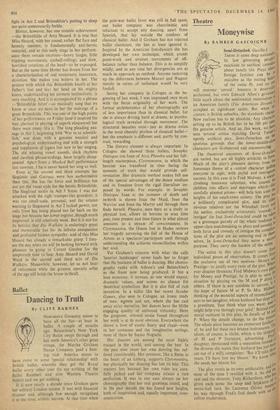Ballet
Dancing to Truth
By CLIVE BARNES It is now nearly a decade since Graham gave her solitary London season. It met with financial disaster and, although few enough recognised it at the time, artistic success. At that time when the post-war ballet fever was still in full spate, our ballet company was chauvinistic and reluctant to accept any dancing, apart from Spanish, that lay outside the confines of classical ballet. And if Graham has not rejected ballet classicism, she has at least ignored it.
Inspired by the American free-dancers she has developed her own technique, which avoids point-work and stresses movements of off- balance rather than balance. This is to simplify wildly, and in any case her divergencies are as much in approach as method. Anyone summing up the differences between Mozart and Wagner merely in terms of technique would be very foolish.
Seeing her company in Cologne at the be- ginning of last week, I was impressed once more with the fierce originality of her work. The formal architectonics of her choreography are of less importance than in classical ballet, for she is always driving hard at drama, at psycho- logical truth revealed through movement The structural beauties exist—just as drama exists in the most chastely plotless of classical ballet— but the emphasis is different and, partly by con- trast, rewarding.
The literary element is always important. In Cologne she showed three ballets, Seraphic Dialogue (on Joan of Arc), Phaedra and her full- length masterpiece, Clytemnestra, in which the heroine was transfixed in time facing the moment of truth that would provide self- revelation. Her dramatic method makes full use of the special advantages of the dance medium and its freedom from the rigid liberalism im- posed by words. For example, in Seraphic Dialogue Joan at the moment of death and re-birth is shown Joan the Maid, Joan the Warrior and Joan the Martyr and through them finds herself. Phaedra, seen here as a study in physical lust, allows its heroine to scan time past, time present and time future in what almost amounts to a stream of consciousness. In Clytemnestra, the Queen lost in Hades reviews her tragedy surveying the fall of the House of Atreus as a spectator/participant until through understanding she achieves reconciliation within her soul.
Yet Graham's concern with what she calls 'interior landscapes' never leads her to forget that the business of ballet is dancing. Her choreo- graphy ranks with Ashton's and Balanchine's as the finest now being produced. It has a lean economy, it stresses, as one would expect, dramatic values, and misses no chance for theatrical symbolism. But it is also full of rich invention. In a ballet like her recent Secular Games, also seen in Cologne, an ironic study of men, nmen and sex, where she has cast away strict narrative, her dances have the blithe engaging quality of unforced virtuosity. Here the gorgeous, oriental strain found throughout her work is at its most obvious. Everywhere she shows a love of exotic finery and ritual—even in her costumes and the imaginative settings, most of them by Isamu Noguchi.
Her dancers are among the most highly trained in the world, and among the best. In the past nine years her own dancing has suf- fered considerably. Her presence, like a flame in the heart of an iceberg, supports Clytemnestra, but physically her dancing has lost its bite. This matters less because her own roles are care- fully picked and her company attains a rare perfection. It was in any case always on her choreography that her real greatness rested, and in the past decade she has found new heights, both of inspiration and, equally important, com- munication.


































 Previous page
Previous page